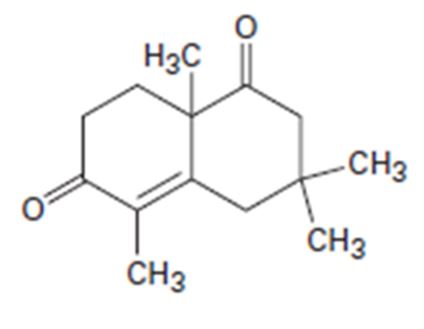
OWLv2 with Student Solutions Manual eBook, 4 terms (24 months) Printed Access Card for McMurry's Organic Chemistry, 9th
9th Edition
ISBN: 9781305671874
Author: John E. McMurry
Publisher: Cengage Learning
expand_more
expand_more
format_list_bulleted
Concept explainers
Textbook Question
Chapter 23.12, Problem 22P
How would you prepare the following compound using a Robinson annulation reaction between a β-diketone and an α, β-unsaturated

Expert Solution & Answer
Trending nowThis is a popular solution!

Students have asked these similar questions
When talking about the acidity of carboxylic acids, is it the same thing to say higher or stronger acidity?
Using the following two half-reactions, determine the pH range in which $NO_2^-\ (aq)$ cannot be found as the predominant chemical species in water.* $NO_3^-(aq)+10H^+(aq)+8e^-\rightarrow NH_4^+(aq)+3H_2O(l),\ pE^{\circ}=14.88$* $NO_2^-(aq)+8H^+(aq)+6e^-\rightarrow NH_4^+(aq)+2H_2O(l),\ pE^{\circ}=15.08$
Indicate characteristics of oxodec acid.
Chapter 23 Solutions
OWLv2 with Student Solutions Manual eBook, 4 terms (24 months) Printed Access Card for McMurry's Organic Chemistry, 9th
Ch. 23.1 - Prob. 1PCh. 23.1 - Prob. 2PCh. 23.3 - Prob. 3PCh. 23.3 - Prob. 4PCh. 23.4 - Prob. 5PCh. 23.4 - 1-Butanol is prepared commercially by a route that...Ch. 23.4 - Prob. 7PCh. 23.5 - Prob. 8PCh. 23.6 - Prob. 9PCh. 23.6 - What product would you Expect to obtain from base...
Ch. 23.7 - Show the products you would expect to obtain by...Ch. 23.7 - Prob. 12PCh. 23.8 - What product would you expect from the following...Ch. 23.9 - What product would you expect From the following...Ch. 23.9 - Prob. 15PCh. 23.10 - Prob. 16PCh. 23.10 - Prob. 17PCh. 23.10 - Prob. 18PCh. 23.11 - Prob. 19PCh. 23.11 - Show how you might use an enamine reaction to...Ch. 23.12 - Prob. 21PCh. 23.12 - How would you prepare the following compound using...Ch. 23.SE - Prob. 23VCCh. 23.SE - Prob. 24VCCh. 23.SE - Prob. 25VCCh. 23.SE - The following molecule was formed by a Robinson...Ch. 23.SE - Prob. 27MPCh. 23.SE - Prob. 28MPCh. 23.SE - Predict the product(s) and provide the mechanism...Ch. 23.SE - Predict the product(s) and provide the mechanism...Ch. 23.SE - Predict the product(s) and provide the mechanism...Ch. 23.SE - Knoevenagel condensation is a reaction involving...Ch. 23.SE - Azlactones are important starting materials used...Ch. 23.SE - Prob. 34MPCh. 23.SE - Isoleucine, another of the twenty amino acids...Ch. 23.SE - The first step in the citric acid cycle of food...Ch. 23.SE - Prob. 37MPCh. 23.SE - The Knoevenagel reaction is a carbonyl...Ch. 23.SE - The Darzens reaction invoIves a two-step,...Ch. 23.SE - The following reaction involves a hydrolysis...Ch. 23.SE - Prob. 41MPCh. 23.SE - Prob. 42MPCh. 23.SE - Prob. 43MPCh. 23.SE - Propose a mechanism for the following...Ch. 23.SE - Prob. 45MPCh. 23.SE - Prob. 46MPCh. 23.SE - Prob. 47MPCh. 23.SE - Prob. 48APCh. 23.SE - Prob. 49APCh. 23.SE - Prob. 50APCh. 23.SE - Prob. 51APCh. 23.SE - Prob. 52APCh. 23.SE - Prob. 53APCh. 23.SE - Prob. 54APCh. 23.SE - Prob. 55APCh. 23.SE - Prob. 56APCh. 23.SE - Prob. 57APCh. 23.SE - Prob. 58APCh. 23.SE - In the mixed Claisen reaction of cyclopentanone...Ch. 23.SE - Ethyl dimethylacetoacetate reacts instantly at...Ch. 23.SE - Prob. 61APCh. 23.SE - Prob. 62APCh. 23.SE - The so-called Wieland-Miescher ketone is a...Ch. 23.SE - Prob. 64APCh. 23.SE - Prob. 65APCh. 23.SE - Prob. 66APCh. 23.SE - What condensation products would you expect to...Ch. 23.SE - The following reactions are unlikely to provide...Ch. 23.SE - Fill in the missing reagents a-h in the following...Ch. 23.SE - Prob. 70APCh. 23.SE - Prob. 71APCh. 23.SE - Prob. 72APCh. 23.SE - Prob. 73AP
Knowledge Booster
Learn more about
Need a deep-dive on the concept behind this application? Look no further. Learn more about this topic, chemistry and related others by exploring similar questions and additional content below.Similar questions
- What is the final product when hexanedioic acid reacts with 1º PCl5 and 2º NH3.arrow_forwardWhat is the final product when D-galactose reacts with hydroxylamine?arrow_forwardIndicate the formula of the product obtained by reacting methyl 5-chloro-5-oxopentanoate with 1 mole of 4-penten-1-ylmagnesium bromide.arrow_forward
- The temperature on a sample of pure X held at 1.25 atm and -54. °C is increased until the sample boils. The temperature is then held constant and the pressure is decreased by 0.42 atm. On the phase diagram below draw a path that shows this set of changes. pressure (atm) 2 0 0 200 400 temperature (K) Xarrow_forwardQUESTION: Answer Question 5: 'Calculating standard error of regression' STEP 1 by filling in all the empty green boxes *The values are all provided in the photo attached*arrow_forwardpressure (atm) 3 The pressure on a sample of pure X held at 47. °C and 0.88 atm is increased until the sample condenses. The pressure is then held constant and the temperature is decreased by 82. °C. On the phase diagram below draw a path that shows this set of changes. 0 0 200 temperature (K) 400 аarrow_forward
arrow_back_ios
SEE MORE QUESTIONS
arrow_forward_ios
Recommended textbooks for you

 Organic ChemistryChemistryISBN:9781305580350Author:William H. Brown, Brent L. Iverson, Eric Anslyn, Christopher S. FootePublisher:Cengage Learning
Organic ChemistryChemistryISBN:9781305580350Author:William H. Brown, Brent L. Iverson, Eric Anslyn, Christopher S. FootePublisher:Cengage Learning EBK A SMALL SCALE APPROACH TO ORGANIC LChemistryISBN:9781305446021Author:LampmanPublisher:CENGAGE LEARNING - CONSIGNMENT
EBK A SMALL SCALE APPROACH TO ORGANIC LChemistryISBN:9781305446021Author:LampmanPublisher:CENGAGE LEARNING - CONSIGNMENT


Organic Chemistry
Chemistry
ISBN:9781305580350
Author:William H. Brown, Brent L. Iverson, Eric Anslyn, Christopher S. Foote
Publisher:Cengage Learning

EBK A SMALL SCALE APPROACH TO ORGANIC L
Chemistry
ISBN:9781305446021
Author:Lampman
Publisher:CENGAGE LEARNING - CONSIGNMENT
Alcohols, Ethers, and Epoxides: Crash Course Organic Chemistry #24; Author: Crash Course;https://www.youtube.com/watch?v=j04zMFwDeDU;License: Standard YouTube License, CC-BY